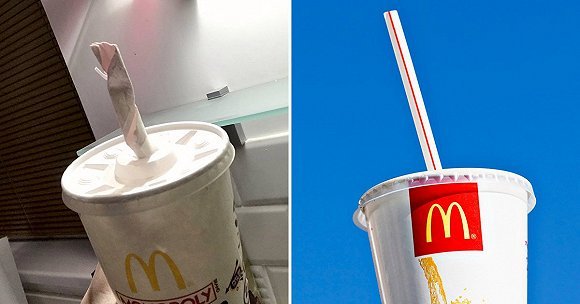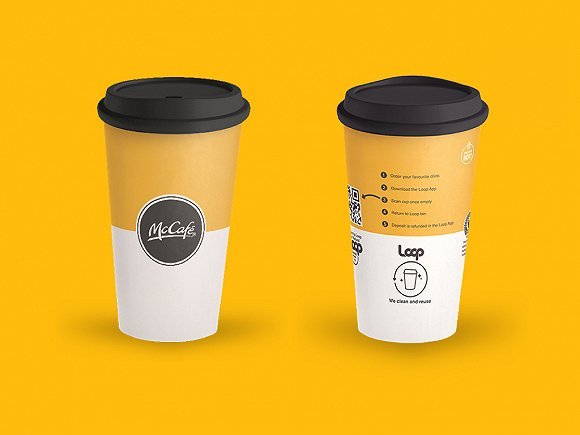In the face of the tightest ever plastic ban, food businesses in China have started a frantic search for eco-friendly alternatives. In the end, it is still up to consumers, who vote with their wallets, to decide how far the policy can go.

Photo: cfp
By LIU Yujing
Since Starbucks introduced strawless lids for its iced coffee in 2018, China’s suckers have found themselves wondering whether their straw is really necessary.
Starbucks had dumped single-use plastic straws in all its stores in China. McDonalds uses paper packaging for at least 80 percent of products. Domestic chains have tried to keep up. Hey Tea provides paper straws alongside plastic ones. During the National Day Holiday in early October, Naixuecha, another beverage chain, used more than a million paper straws.
Trailing far behind the growing public awareness of the damage done by the production and distribution of products no one needs, come new regulations. In January, a plastic ban for single-use plastic products surfaced, though it will take five years of mounting waste before the prohibition is fully in force, and more or less nothing is to be done until the end of next year.
A frenetic search has begun for substitutes, rather than the preferred alternative of eliminating superfluous packaging completely. The price per ton of polylactic acid (PLA) plastic, which decomposes more easily than some plastics, has risen from 30,000 yuan (US$4,500) per ton to 50,000 yuan in less than a year. Restaurants and suppliers are still searching for ways of maintaining their profits while reducing their environmental footprint, but it is really up to consumers to vote with their wallets.
A straw that does not suck
Straws form only 0.036 percent of all plastic products in China, but their familiarity has made them an easy first target in the plastic ban. Each Chinese person used 30 plastic straws last year, around 6.5 meters each. With around 1.4 billion people in China that equates to around 10 million kilometers of completely unnecessary plastic objects, enough to reach to the moon every two weeks.
With the exceptions of glass or stainless steel, most non-plastic straws are paper or PLA. Neither is cheap. Paper straws, the more common of the two, cost 0.1 yuan each to manufacture, more than three times the cost of plastic ones. PLA straws are even costlier.
Paper straws can become soggy, or even turn to mush before the drink is finished. In the UK, McDonald’s had to strengthen its paper straws by making them thicker to the extent that it became impossible to recycle. At Hey Tea, most customers still opt for plastic. “Most complaints are about durability and performance,” said a spokesperson. “We are working on a better recyclable alternative.”

PLA straws, on the other hand, are made to decay. They start to break down after a year, compared to two to three years for paper straws, but their popularity is increasing, according to
LI Erqiao, whose factory in Zhejiang makes both. Demand jumped in 2018, when full-blown campaigns to phase out plastic straws began in Europe and North America. Lagging behind, domestic orders picked up a year later. Li’s factory now makes 200 tons of PLA straws each year, about the same as the paper version.
Li explained that China cannot make all the PLA it consumes, and has to import from North America. “Western producers prioritize their home markets, which are also banning plastics,” he said. Short supply keeps prices high, which, combined with the short shelf life, makes PLA straws less attractive, at least economically.
A partial solution only
Straws are only tip of the iceberg, at least for as long as we still have icebergs. Food containers use a lot more plastic than straws. And these seemingly eco-friendly improvements, as it turns out, are only self-congratulatory partial solutions.
To increase water resistance and durability, many paper food containers are lined with polyethylene (PE) or polypropylene (PP). These are hard, if not impossible, to recycle and perhaps worse than the packages they replace. The vast majority still end up in incinerators or landfills. Nonetheless paper containers still reduce plastic pollution since the coating typically makes up only 10 percent of all material used. A solution will be found, but not overnight.
Coffee chains have encouraged customers to bring their own mugs. In the UK, McDonald’s customers can pay a deposit for special paper mugs, which are washed and reused before being recycled. Some manufacturers are developing degradable coatings, others have focused on laminating and recycling to make paper-plastic separation easier. New materials are still at proof-of-concept stage and not yet economically. Single-use food packages made from wood fiber are expensive and limited to high-end restaurants. Most restaurants still opt for inexpensive conventional containers.

Higher costs mean higher prices and customers have proved to be very resistant. Diners protested vehemently to a new 0.5-yuan charge for disposable utensils at McDonald's. Sandwiched between a strict plastic ban and hard-to-please customers, it is almost entirely up to the restaurants themselves to decide how eco-friendly they want to be.
Lofty but easy to implement
The entire industry, from restaurants to factories, are all-hands-on deck for the plastic ban. Li is optimistic that his company will keep up when the food business inevitably goes zero plastic. But is it just for the private sector alone to put its own house in order? There is no doubt that the fast-food and coffee businesses are hugely profitable, but policymakers, regulators, and even the media need to pull together. Incentivizing eco-friendly corporate initiatives, fine tuning standards and enforcing compliance require a broad conversation on global warming and the kind of future we want for ourselves.
“Policies need to be workable,” LI told Jiemian News. “If the goal is so lofty as to be beyond reach, it’s no use at all.” There are concerns that it is “unrealistic” for China to ban plastic completely in the short run, and a lot more need to be done on waste management and recycling.
Many provinces are phasing out plastic straws gradually. Hainan, a tourist hot spot, started banning all single-use plastics in tourist sights and shopping malls this spring. The ban is being expanded to other venues, and the entire island is expected to be free of single-use plastic by December. If successful, the experience will be the benchmark for other regions.
But in the end, the effort to go plastic free still starts from a small choice on every commuter’s daily coffee run.